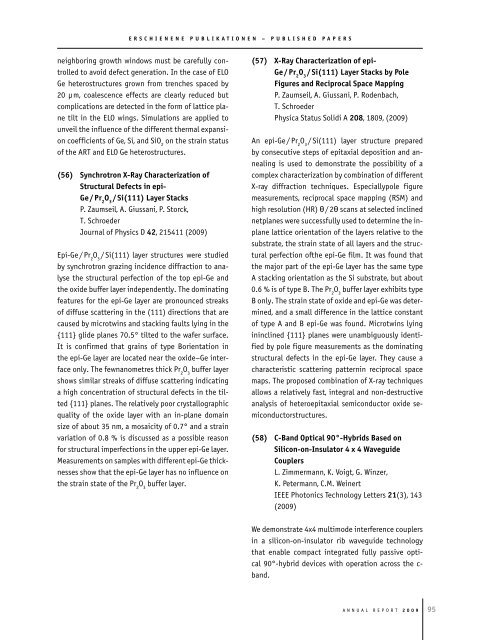Deliverables and Services - IHP Microelectronics
Deliverables and Services - IHP Microelectronics
Deliverables and Services - IHP Microelectronics
You also want an ePaper? Increase the reach of your titles
YUMPU automatically turns print PDFs into web optimized ePapers that Google loves.
e r S C H I e N e N e p u B L I K A t I o N e N – p u B L I S H e d p A p e r S<br />
neighboring growth windows must be carefully controlled<br />
to avoid defect generation. In the case of elo<br />
Ge heterostructures grown from trenches spaced by<br />
20 µm, coalescence effects are clearly reduced but<br />
complications are detected in the form of lattice plane<br />
tilt in the elo wings. Simulations are applied to<br />
unveil the influence of the different thermal expansion<br />
coefficients of Ge, Si, <strong>and</strong> Sio 2 on the strain status<br />
of the ARt <strong>and</strong> elo Ge heterostructures.<br />
(56) Synchrotron X-ray Characterization of<br />
Structural defects in epi-<br />
Ge / pr 2 o 3 / Si(111) Layer Stacks<br />
p. Zaumseil, A. Giussani, p. Storck,<br />
t. Schroeder<br />
Journal of physics D 42, 215411 (2009)<br />
epi-Ge / pr 2 o 3 / Si(111) layer structures were studied<br />
by synchrotron grazing incidence diffraction to analyse<br />
the structural perfection of the top epi-Ge <strong>and</strong><br />
the oxide buffer layer independently. the dominating<br />
features for the epi-Ge layer are pronounced streaks<br />
of diffuse scattering in the (111) directions that are<br />
caused by microtwins <strong>and</strong> stacking faults lying in the<br />
{111} glide planes 70.5° tilted to the wafer surface.<br />
It is confirmed that grains of type Borientation in<br />
the epi-Ge layer are located near the oxide–Ge interface<br />
only. the fewnanometres thick pr 2 o 3 buffer layer<br />
shows similar streaks of diffuse scattering indicating<br />
a high concentration of structural defects in the tilted<br />
{111} planes. the relatively poor crystallographic<br />
quality of the oxide layer with an in-plane domain<br />
size of about 35 nm, a mosaicity of 0.7° <strong>and</strong> a strain<br />
variation of 0.8 % is discussed as a possible reason<br />
for structural imperfections in the upper epi-Ge layer.<br />
Measurements on samples with different epi-Ge thicknesses<br />
show that the epi-Ge layer has no influence on<br />
the strain state of the pr 2 o 3 buffer layer.<br />
(57) X-ray Characterization of epi-<br />
Ge / pr 2 o 3 / Si(111) Layer Stacks by pole<br />
Figures <strong>and</strong> reciprocal Space Mapping<br />
p. Zaumseil, A. Giussani, p. Rodenbach,<br />
t. Schroeder<br />
physica Status Solidi A 208, 1809, (2009)<br />
An epi-Ge / pr 2 o 3 / Si(111) layer structure prepared<br />
by consecutive steps of epitaxial deposition <strong>and</strong> annealing<br />
is used to demonstrate the possibility of a<br />
complex characterization by combination of different<br />
X-ray diffraction techniques. especiallypole figure<br />
measurements, reciprocal space mapping (RSM) <strong>and</strong><br />
high resolution (HR) θ / 2θ scans at selected inclined<br />
netplanes were successfully used to determine the inplane<br />
lattice orientation of the layers relative to the<br />
substrate, the strain state of all layers <strong>and</strong> the structural<br />
perfection ofthe epi-Ge film. It was found that<br />
the major part of the epi-Ge layer has the same type<br />
A stacking orientation as the Si substrate, but about<br />
0.6 % is of type B. the pr 2 o 3 buffer layer exhibits type<br />
B only. the strain state of oxide <strong>and</strong> epi-Ge was determined,<br />
<strong>and</strong> a small difference in the lattice constant<br />
of type A <strong>and</strong> B epi-Ge was found. Microtwins lying<br />
ininclined {111} planes were unambiguously identified<br />
by pole figure measurements as the dominating<br />
structural defects in the epi-Ge layer. they cause a<br />
characteristic scattering patternin reciprocal space<br />
maps. the proposed combination of X-ray techniques<br />
allows a relatively fast, integral <strong>and</strong> non-destructive<br />
analysis of heteroepitaxial semiconductor oxide semiconductorstructures.<br />
(58) C-B<strong>and</strong> optical 90°-Hybrids Based on<br />
Silicon-on-Insulator 4 x 4 waveguide<br />
Couplers<br />
l. Zimmermann, K. Voigt, G. Winzer,<br />
K. petermann, C.M. Weinert<br />
Ieee photonics technology letters 21(3), 143<br />
(2009)<br />
We demonstrate 4x4 multimode interference couplers<br />
in a silicon-on-insulator rib waveguide technology<br />
that enable compact integrated fully passive optical<br />
90°-hybrid devices with operation across the cb<strong>and</strong>.<br />
A n n u A l R e p o R t 2 0 0 9<br />
9










